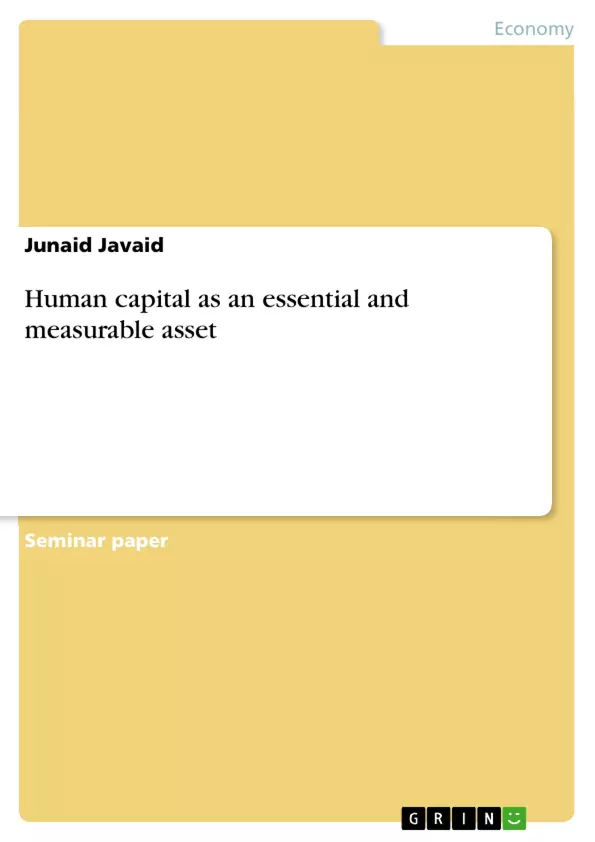This AMP is carried out as a research toward finding and relating the company’s Human Capital with its desired performance. It has also suggested the method by which the company can reliably reports its Human Capital as the strongest company’s asset in its financial statements. From the Background context of given issue the evidence looks prominent and right that in the current scenario Human Capital is considered to be as the key success factor. The Literature Review section, in relation to the definition of Human Capital, the arguments of both Becker (1993) and Davenport (1999) makes sense and also looks generous. Becker (1993) defined Human Capital as a composition of four characteristics (Credentials, Reputation, Personality and Appearance). While on the other side, Davenport (1999) made a figure of by combining all aspects (Employee effort, behaviour, ability & time) together to give final shape to undergoing definition. In relations to the measurement methods of Human Capital, there are many Scholars who came forwards and proposed different methods. It has been regarded and acknowledged that work of certain Authors: Kaplan & Norton (1992), Monti-Belkaou & Riahi-Belkaoui (1995), Brown (1999) and Weiss (1999) is prominent. Out of these four studies Monti-Belkaou & Riahi-Belkaoui (1995) took the fame as their model have both aspect: practical implementation and recognition of value added by the company’s demployed Human Capital in its overall financial performance and operational excellence. The objectives of this AMP have been achieved. From the models like Balanced Scorecard and Kaplan’s Seven Step Framework and also from the case studies like Huselid, et al (1997) and Delery & Doty, (1996), it has been cleared and understood that the company’s Human Capital has implications on its business performance (success). From the studies like Kaplan & Norton (1992), Monti-Belkaou & Riahi-Belkaoui (1995), Brown (1999) and Weiss (1999), it has illustrated that these are the certain methods by which the company could include Human Capital as the company’s most significant in its financial reporting. Out of these four studies, Monti-Belkaou & Riahi-Belkaoui (1995) took the fame. So the need of an hour is to select it as the common framework for the reporting of Human Capital as the company’s most powerful assets.
Inhaltsverzeichnis (Table of Contents)
- Chapter:1 – Aims & Objectives
- Background Context
- Problem Discussion
- Problem Statement (Question)
- Aims
- Objectives
- Summary
- Chapter:2 – Literature Review
- Human Capital
- Linking Human Capital with Profitability
- Human Capital Measurement: An Evolution
- Why it is Important to Report Human Capital (HC)
- Summary
- Chapter:3 – Case Studies
- Case-Study 1: (Ichniowski, et al., 1997)
- Case-Study 2: (Huselid, et al., 1997)
- Case-Study 3: (Delery & Doty, 1996)
- Case-Study 4: (Youndt, et al., 1996)
- Summary
Zielsetzung und Themenschwerpunkte (Objectives and Key Themes)
This Applied Management Project (AMP) investigates the relationship between a company's human capital and its desired performance. The project aims to understand the significance of Human Capital reporting and to suggest methods by which companies can reliably include it in their financial statements.
- The importance of Human Capital as a key success factor in today's economy.
- The link between Human Capital and company performance, using various indicators to measure success.
- The challenges and methods for measuring and reporting Human Capital in financial statements.
- The impact of Human Capital management practices on company profitability and competitiveness.
- The value added by Human Capital and the need for incorporating it into corporate reporting.
Zusammenfassung der Kapitel (Chapter Summaries)
Chapter 1: Aims & Objectives introduces the background context of the project, focusing on the growing importance of intangible assets, particularly Human Capital, in the service-based economy. It highlights the challenges companies face in valuing and reporting Human Capital, leading to the problem statement: exploring the correlation between Human Capital and business success and evaluating methods for reporting Human Capital as an asset in financial statements.
Chapter 2: Literature Review delves deeper into the concept of Human Capital, examining its definition, composition, and measurement. It reviews various models linking Human Capital to profitability, including the Balanced Scorecard and Kaplan's Seven Step Framework. The chapter discusses different methods proposed for measuring Human Capital, such as the Human Capital Index and the Value Added Statement. It also explores the rationale behind reporting Human Capital and the potential benefits and risks associated with it.
Chapter 3: Case Studies examines the relationship between Human Capital and company performance through four case studies. These studies highlight the positive impact of Human Resource Management practices on worker productivity, company profitability, and market value. They demonstrate the importance of investing in Human Capital for competitive advantage.
Schlüsselwörter (Keywords)
The key themes and concepts explored in this work include human capital, intangible assets, financial reporting, corporate performance, profitability, competitive advantage, value addition, balanced scorecard, value added statement, human capital index, employee productivity, and stakeholder engagement.
- Quote paper
- Junaid Javaid (Author), 2012, Human capital as an essential and measurable asset, Munich, GRIN Verlag, https://www.grin.com/document/281639



